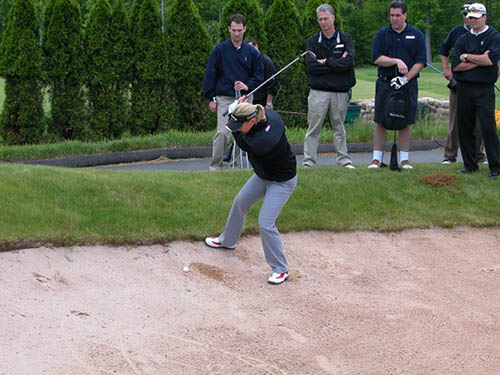Ball Position in a Golf Stance: Awkward Lies

A Legacy Post by Keiser University College of Golf Senior Faculty and Director of Research Dr. T. J. Tomasi (1940-2023)
The first order of business when you arrive at your golf ball is to examine your lie, i.e., the characteristics of how your ball is sitting. Since your lie dictates the kind of shot you can play, part of being a skillful player is “reading” the lie and then being able to execute the required shot.
Bad Golf Lies
There are four basic types of uneven lies:
- Ball above your feet;
- Ball below your feet;
- Downhill slope;
- Uphill slope.
Each of these has a predictable ball flight pattern, and the gravitational forces of the hill will challenge your ability to make a balanced golf swing. Simple adjustments you make in your setup will compensate for the effect the slope has on your body.
What is a Golf Lie
In golf, the term “lie” refers to the positioning or angle of the golf ball in relation to the ground when it comes to rest. It specifically denotes how the ball rests on the turf or in a hazard, influencing the golfer’s ability to execute the next shot. The lie can vary based on factors such as the slope of the ground, the type of surface (fairway, rough, bunker), and any obstacles or irregularities present. A favorable lie provides a golfer with better control and a more predictable shot, while an unfavorable lie, such as a ball sitting in deep rough or on a slope, may present challenges that require adjustments in club selection and shot strategy. Understanding and adapting to different lies is a fundamental aspect of golf strategy, highlighting the importance of versatility and adaptability for players across various course conditions
Keep these effects of uneven lies in mind:
- The ball follows the direction of the slope.
- You’ll lose your balance down the slope.
- The bottom of your swing arc is altered by the slope.
- The path and plane of your swing are altered by the slope.
Although uneven lies are opposites, some adjustments are standard for all. In general, protect your balance by anchoring yourself into the hill, against the pull of gravity. Angle your shoulders to match the slope so you can swing with the contour of the hill. The slope causes changes in your swing arc, so you need to adjust your ball position accordingly. Move the ball back on a right-to-left slope, forward on a left-to-right slope. And finally, opening or closing your stance will neutralize the effect of the slope by returning your hips to level. Close your stance for a right-to-left slope, and open it for the opposite. Once you’ve made the correct adjustments in your setup, you need to do only two more things: The first is to make a smooth, three-quarter swing for maximum control, and the second is to focus on the target.

The great Annika Sorenstam knows how to adjust for a downhill lie by opening her stance, moving the ball back and tilting her shoulders to the angle of the slope.

My stance is closed here, with the ball back, and my weight is toward my toes. I’m aiming right because this shot will curve a lot in the direction of the slope, from right to left.
Learn more!
Want more tips? If you want to take your game to the next level, contact our team at Keiser University’s College of Golf & Sport Management today. With our dedication and experience, we can elevate your game to new heights together. Give us a call today at 888-355-4465.














